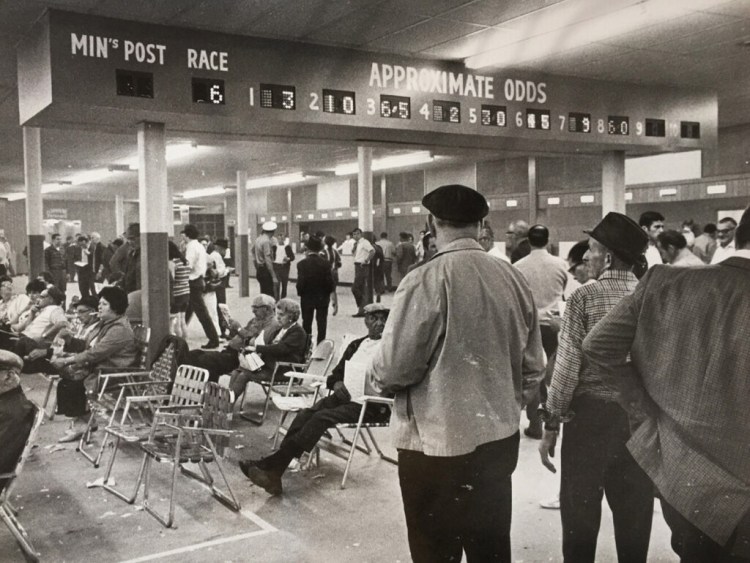July 1, 1950: The newly constructed Scarborough Downs racetrack opens for its first races. The facility includes a grandstand that can hold 6,500 spectators, stables for 1,000 horses and parking for 6,000 cars.

The $1 million complex was carved from a patch of woods in 73 days. The track was built despite opposition from anti-gambling groups and harness racing fans who thought the Scarborough track could harm the nearby Gorham Raceway and local agricultural fairs, which also sponsored races. Legal battles between the two factions last for years.
Alfredo Montiero, riding Fighting Foot in the Governor’s Cup $2,500 opening day feature, claims victory in the first race.
It becomes apparent within weeks that the number of fans is not enough to justify afternoon races, so the racetrack installs lights and becomes the first track in the nation to hold races at night.
In 1959, the track draws an attendance of about 260,000 for a 48-day season, and betting tops $9 million. The track begins to falter financially in the 1960s, when other venues arise to compete with it and vacation visitors’ preferences start to change. Then the New York-based Ogden Corp. buys the track in 1969, makes about $1 million worth of improvements and introduces harness racing.
In the 1970s, the track abandons thoroughbred racing and turns exclusively to harness racing. It also hosts horse shows, a rodeo, band concerts, a square dance convention, a snowmobile show and fairs in an effort to stay in the black.
In 1985, Joseph Ricci, who bought the track in 1979 and continues to own it until his death in 2001, spends $3 million to expand and renovate its facilities.
Maine voters approve a referendum in 2003 authorizing the track to offer its customers access to slot machines, subject to local approval. However, voters in Scarborough and Westbrook, which track officials were considering as an alternate site, shoot down the idea.
State law grants Scarborough Downs a share of the proceeds from racetrack-connected slot machines in Bangor.
July 1, 1999: Reggie Barnes, an employee of demolition contractor H.E. Sargent, uses a giant backhoe to break through the Edwards Dam in Augusta at 9:21 a.m., allowing the Kennebec River to flow freely there for the first time since 1837.
“I thought of wearing a tuxedo, but I also thought better of it,” Barnes, sporting a hard hat, tells the Kennebec Journal. “This shouldn’t take more than 10 minutes, once we get underway.”

John Charest, Augusta’s public works director, watches the Kennebec River flow through the breach from the Edwards Dam block house in 1999. Kennebec Journal file photo by Andy Molloy
The first breaching of a functioning hydroelectric dam comes about because, also for the first time, the Federal Energy Regulatory Commission declines in 1997 to renew the dam’s license despite the owner’s wishes.
Interior Secretary Bruce Babbitt says the demise of the Edwards Dam sets a national precedent that will and should be followed, given the appropriate circumstances.
The dam’s removal helps to restore the fish population in the river and set a template for dam removal projects elsewhere in the country.
The Kennebec Journal, through the repeated urging of editor Luther Severance, played a role in getting the dam built in the first place. In 1825, the year he co-founded the paper, Severance began agitating for the dam’s construction to provide power and encourage industrial development.
The Legislature granted a dam charter in 1834, and a corporation headed by Reuel Williams built the dam from 1836 to 1837.
Presented by:

Joseph Owen is an author, retired newspaper editor and board member of the Kennebec Historical Society. Owen’s book, “This Day in Maine,” can be ordered at islandportpress.com. To get a signed copy use promo code signedbyjoe at checkout. Joe can be contacted at: jowen@mainetoday.com.
Send questions/comments to the editors.



Success. Please wait for the page to reload. If the page does not reload within 5 seconds, please refresh the page.
Enter your email and password to access comments.
Hi, to comment on stories you must . This profile is in addition to your subscription and website login.
Already have a commenting profile? .
Invalid username/password.
Please check your email to confirm and complete your registration.
Only subscribers are eligible to post comments. Please subscribe or login first for digital access. Here’s why.
Use the form below to reset your password. When you've submitted your account email, we will send an email with a reset code.